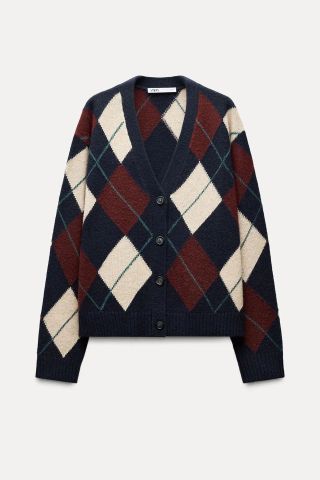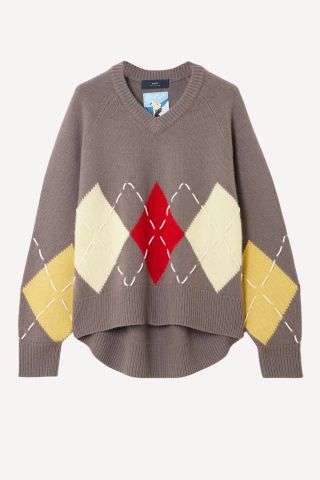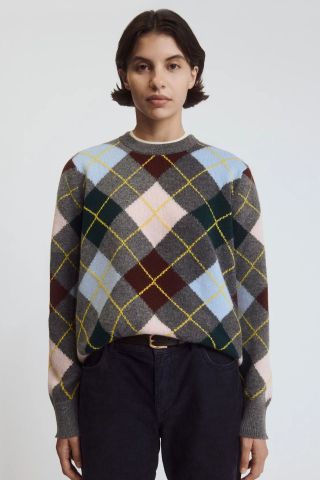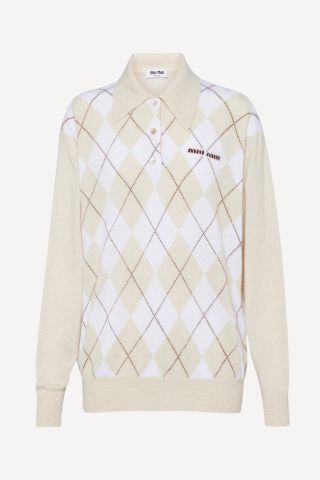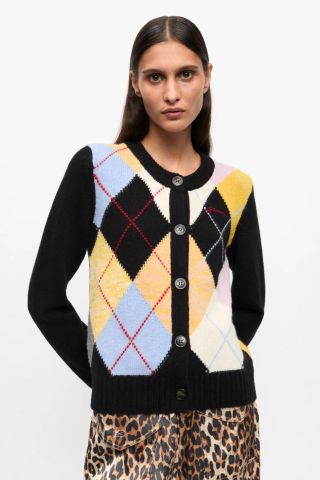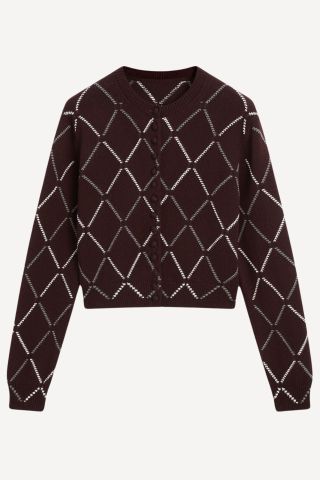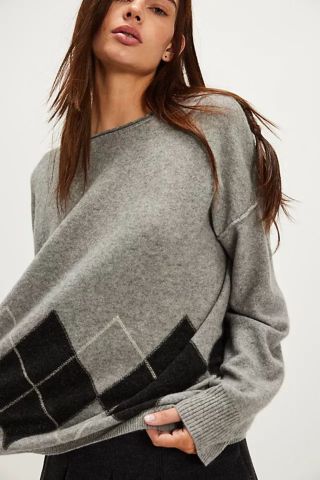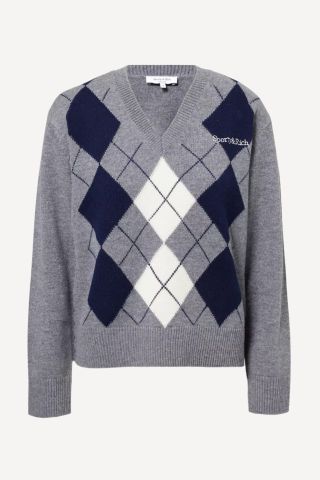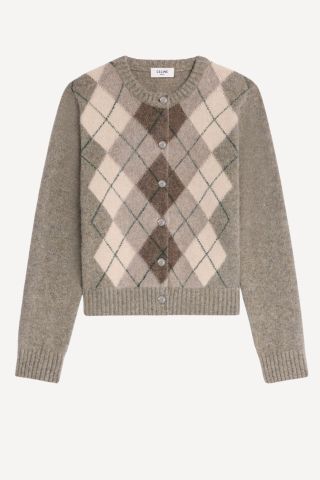Welcome to Icons Only, Who What Wear’s deep dive into classic items that are again under the spotlight. This month, journalist Emma McCarthy takes us on a journey through Scotland via Hollywood and Miuccia Prada’s mind to decode the relevance and potted history of the argyle knit.
Is it just me, or is golf suddenly chic? Okay, maybe not playing actual golf (I have zero intention of teeing off in the foreseeable) but I am seriously considering raiding my grandpa’s wardrobe for one of his old golf jumpers…
Apparently, it’s not just me. Argyle is having a moment. It’s on the catwalk at Miu Miu. It’s flying off the shelves on every corner of the high street. It’s giving Clueless meets The Crown. It’s equal parts English country estate and senior class president. It’s also the logical evolution in fashion’s sporting love affair; if you’re a fan of the football shirt and joined the scrum for a rugby top, then you may get into the swing of the new season with a golf jumper!
But precisely how did an arguably ugly knit with a history dating back some 400-odd years and associations with the world’s most boring sport become Gen-Z’s 2025 cult item? I feel a deep dive coming on…
The Origins
(Image credit: Getty Images)
As legend has it the first argyle was created by accident, when a rugged highland warrior ripped his kilt and turned the tartan check diagonal. As wonderfully Braveheart as this tale is, it’s also likely that it is, sadly, no more than a myth. The true origin of the argyle is that it was invented sometime in the 17th Century and originates from Clan Campbell of Argyll in western Scotland. Its distinctive diamond pattern was also something of a technical innovation of its time when it was discovered that turning traditional tartan squares at a 90-degree angle produces a more form-fitting weave.
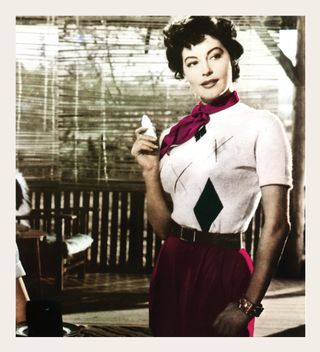
Ava Gardner wearing an argyle sweater.
(Image credit: Getty Images)
Fast forward to the early 20th Century and the introduction of Pringle of Scotland’s signature argyle, which single-handedly popularised the pattern amongst the masses. Among its early adopters was the Duke of Windsor, a keen golfer, and this royal seal of approval led to its popularity amongst the fashionable sporting set throughout the 1920s.
Icons in Argyle Knits
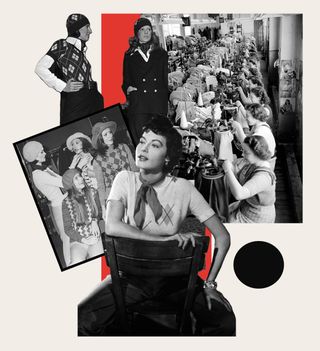
(Image credit: Getty Images)
Grace Kelly was famously partial to a Pringle twinset. And to this day, argyle has no shortage of celebrity fans, from Hailey Bieber to Harry Styles and Taylor Swift. In fact, earlier this year, there was even an entire film named in its honour, courtesy of Matthew Vaugh’s star-studded spy caper Argylle, which featured Henry Cavill and Dua Lipa alongside Claudia Schiffer’s cat, who spends most of the film being carried around in an argyle-print backpack. But I digress…

Argyle knitwear as seen in Clueless, Friends and Mean Girls.
(Image credit: Getty Images)
My point is that argyle’s iconography is so embedded in our collective subconscious that it is often used in film and TV to denote a character’s personality. Who could forget Cher Horowitz in Clueless, striding down Rodeo Drive laden with shopping bags dressed in an argyle skirt? Or OG Plastic Gretchen Wieners scheming and trying to make “fetch” happen while dressed in a pink argyle sweater in Mean Girls? Or Queen B of the Upper East Side, Gossip Girl’s Blair Waldorf (and, for that matter, Chuck Bass). All these characters have something in common; they’re all stinking rich. Historically, golf was considered a ‘gentleman’s game’ and so, became a stereotype for affluence. As a result, argyle’s deep association with the elite sport means it, too, has become synonymous with a privileged, preppy aesthetic.
The aspirational Ivy League country club aesthetic was co-opted by hip-hop culture in the 80s. Through the endorsement of brands like Polo Ralph Lauren and Tommy Hilfiger, the same classic elitist codes were subverted and the look gained street credibility. Outkast’s Andre 3000, Louis Vuitton designer Pharrell Williams and Tyler the Creator, who founded his preppy fashion label Golf le Fleur, are all renowned for their ironically natty style.
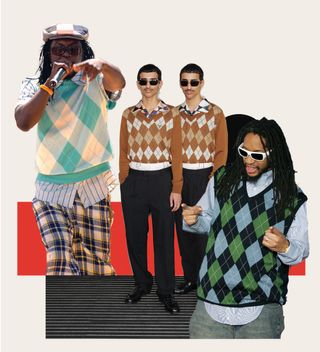
Will.I.Am, Mohammed and Humaid Hadban and Lil Jon wearing argyle sweaters.
(Image credit: Getty Images)
In British culture, this alt-rebellion translated onto the terraces and the ‘80s football casuals, for whom dressing in the latest designer labels and high-end sportswear, from Stone Island to Fred Perry, became a status symbol. An argyle sweater suited this subculture down to a tee and became an emblem of youth rebellion, worn by the likes of Trainspotting’s angriest protagonist, Francis “Franco” Begbie.
The Argyle Trend
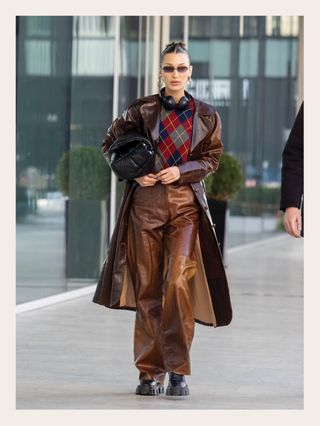
Bella Hadid wearing an argyle sweater.
(Image credit: Getty Images)
That’s enough of the history lesson. What matters is that argyle’s myriad interpretations—a bit 90s, a bit aristocratic, a bit renegade—makes it ideal for a new generation who like their moodboard references to be left-field and intentionally ambiguous.

Micheal Ward at Burberry, Victoria Beckham and Linda Evangelista walking at Vivienne Westwood wearing argyle knitwear.
(Image credit: Getty Images)
At the onset of 2024, Pinterest coined the “Eclectic Grandpa” aesthetic among its zeitgeist-y trend predictions—think clothes driven by comfort and idiosyncrasy, like weird and wonderful knitwear, preferably thrifted and even better if once owned by an actual grandpa. The menswear section of your local charity or vintage shop would be a great place to start your search for an original argyle golf jumper fresh out of mothball storage. Or try scrolling through ‘80s knitwear gold on eBay or Vinted.
On the Runway
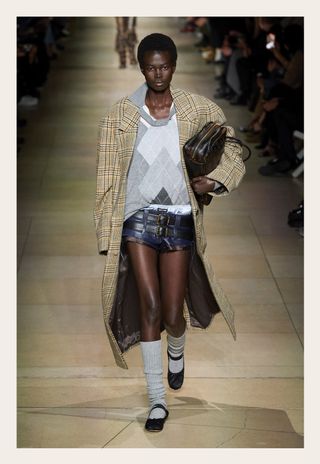
An argyle sweater on a model at Miu Miu’s AW22 runway show.
(Image credit: Getty Images)
Argyle’s influence extends to high fashion circles too, and is a regular on the catwalk. This season’s current infatuation can be charted back to Miu Miu’s AW22 collection, which featured a host of argyle jumpers worn with micro shorts and power shoulder coats. And where Miuccia Prada goes, the rest of the fashion world eventually follows.
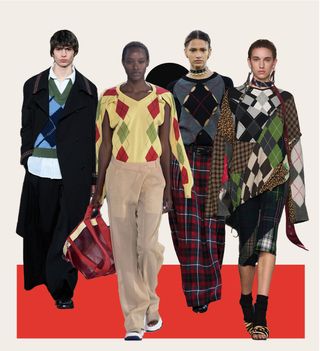
Argyle knitwear on show at SS Daley AW24, Dior SS25, Rave Review FW24 and Toga SS19.
(Image credit: Getty Images)
Dior recently staged a fashion show in Edinburgh, for which creative director Maria Grazia Chiuri recruited the help of local artisans and heritage makers including Samantha McCoach (of Le Kilt), Harris Tweed and Robert Mackie, on a collection loaded with Scotland’s finest tropes including tartan and argyle. This season, argyle was also a mainstay for luxury upcycling label Rave Review, which transformed old sweaters into patchwork dresses and asymmetric tops, as well as being present within the collection of Harry Styles’s favourite SS Daley.
On the Streets
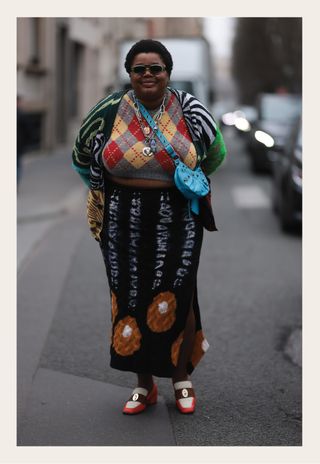
A guest at fashion week wears an argyle sweater.
(Image credit: Getty Images)
Naturally, there is now an abundance of argyle options on the high street. M&S has traditional styles ranging from cardigan to crewneck, all at a very palatable £35. For a more modern iteration, try Zara’s alt-argyles, with their warped scale and deconstructed weave, or look beyond the jumper with Kitri’s argyle mini skirt.

Fashion week guests wearing argyle knitwear.
(Image credit: Getty Images)
As for me, my money’s on slow knitwear brand &Daughter and its Ava Argyle Crewneck. Crafted using traditional methods by small-scale artisans in Scotland’s protected Hawick region, it’s a wise investment if you’re looking for diamonds made to last forever.


